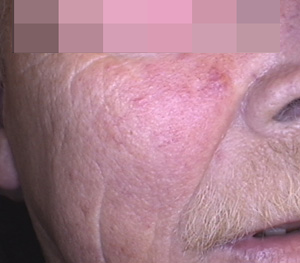Rosacea
Rosacea is common and affects the central part of the face, usually of a middle-aged person. A tendency to flush easily is followed by persistent redness on the cheeks, chin, forehead and nose, and by crops of small inflamed red bumps and pus spots.
Many things seem to make rosacea worse, but probably do not cause it in the first place. They include alcohol, too much exercise, both high and low temperatures, hot spicy foods, stress, and sunlight.
The skin of the face feels sensitive, and can burn or sting. Flushing (the face becomes bright red) adds to the embarrassment caused by the rash. After a while, the central areas of the face become a deeper shade of red. The area becomes studded with small red bumps and pus spots, which come and go in crops. Small dilated blood vessels appear, looking like thin red streaks.
No treatment can be guaranteed to switch rosacea off forever. However long-term treatments control symptoms and can clear the spots. Treatment works best if started when rosacea is at an early stage.
Preparations applied to the skin can sometimes control mild rosacea, or keep rosacea in remission after a course of oral antibiotics. Most people with rosacea, however, need to take antibiotics by mouth from time to time. Topical antibiotic could be used for mild symptoms. Blood vessels are treated with laser.






